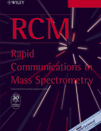This article needs additional citations for verification .(August 2014) |
 | |
| Discipline | Mass Spectrometry, Science of gas-phase ions |
|---|---|
| Language | English |
| Edited by | David Goodlett, John J. Monaghan, Pierre Thibault, Dietrich Volmer |
| Publication details | |
| History | 1987-present |
| Publisher | |
| Frequency | Biweekly |
| 2.419 (2020) | |
| Standard abbreviations | |
| ISO 4 | Rapid Commun. Mass Spectrom. |
| Indexing | |
| CODEN | RCMSEF |
| ISSN | 0951-4198 (print) 1097-0231 (web) |
| LCCN | 88645064 |
| OCLC no. | 643958996 |
| Links | |
Rapid Communications in Mass Spectrometry (RCM) is a biweekly peer-reviewed scientific journal published since 1987 by John Wiley & Sons. It covers research on all aspects of mass spectrometry. According to the Journal Citation Reports , the journal has a 2020 impact factor of 2.419. [1]